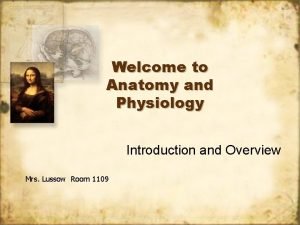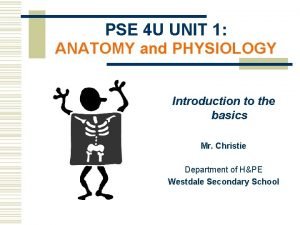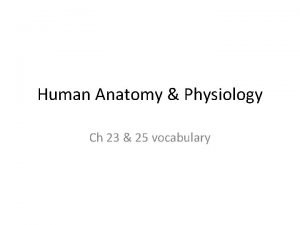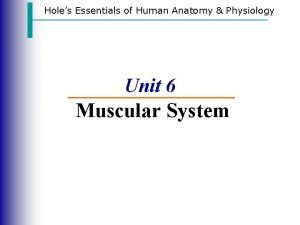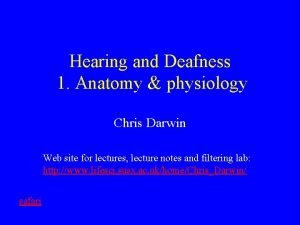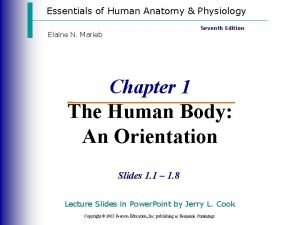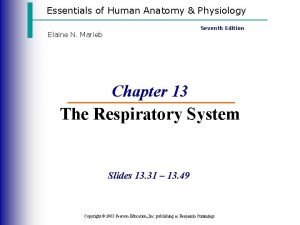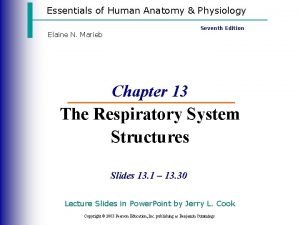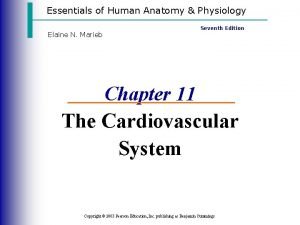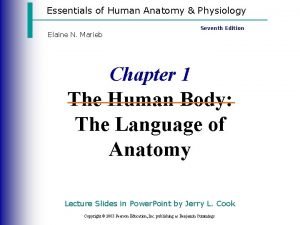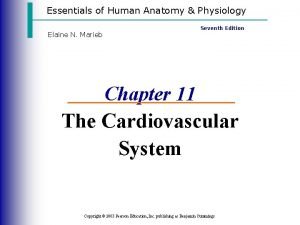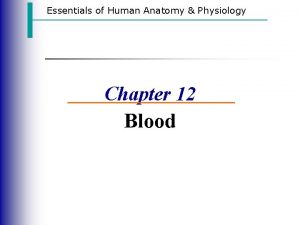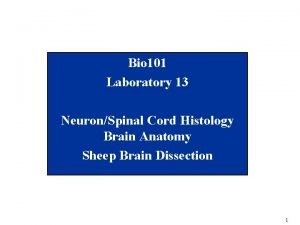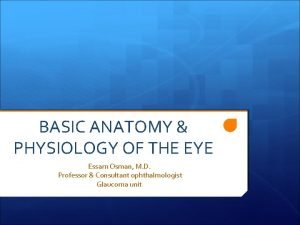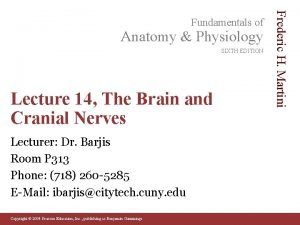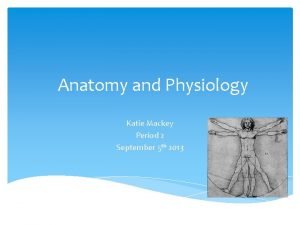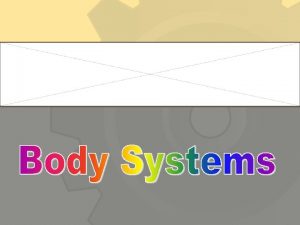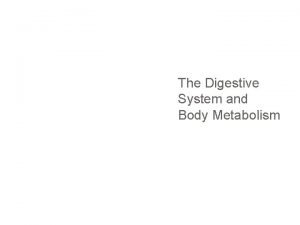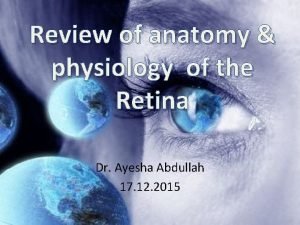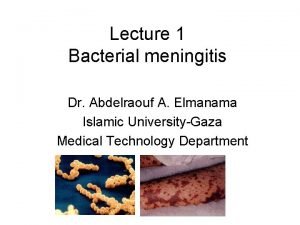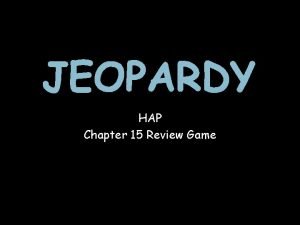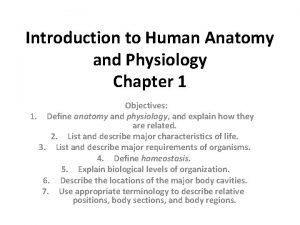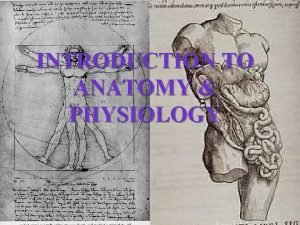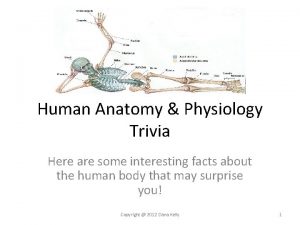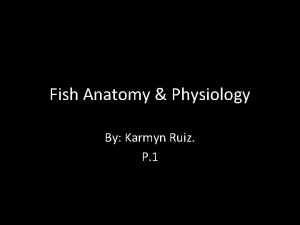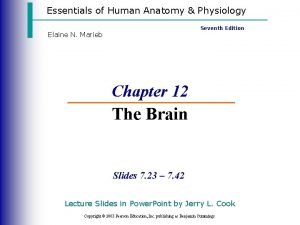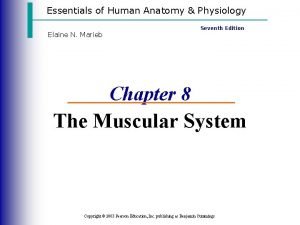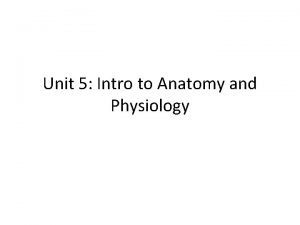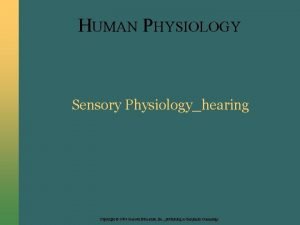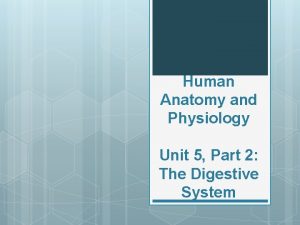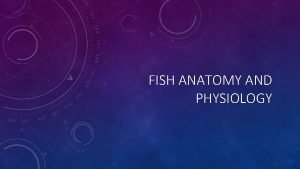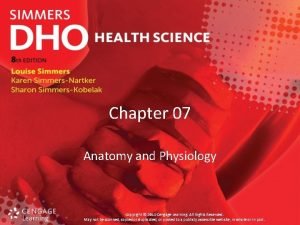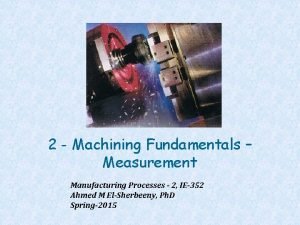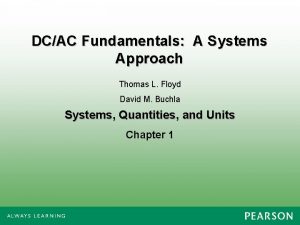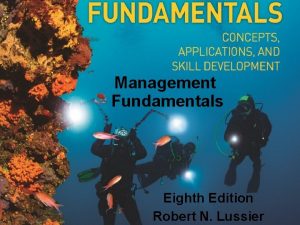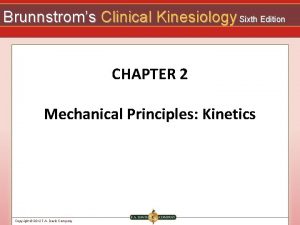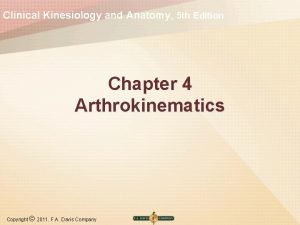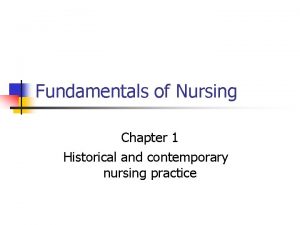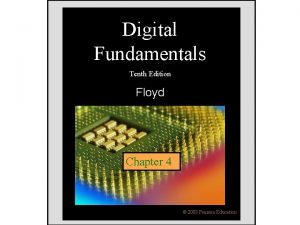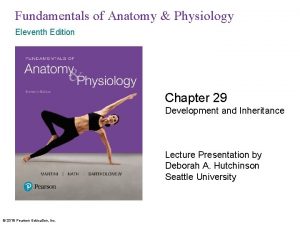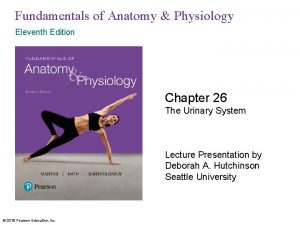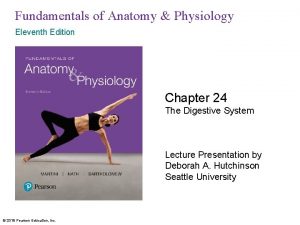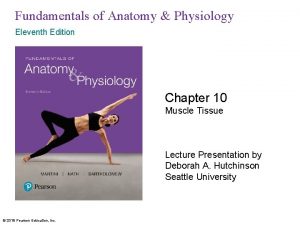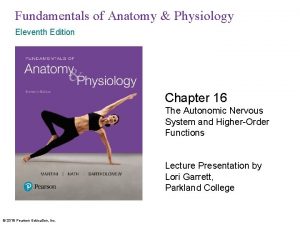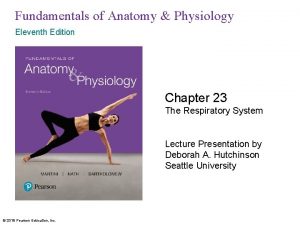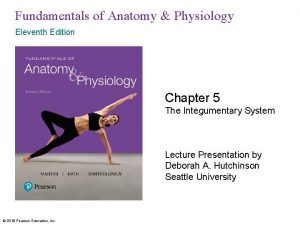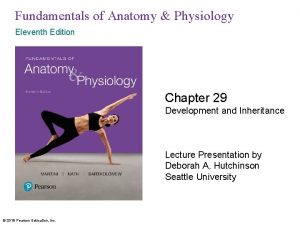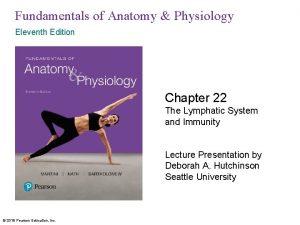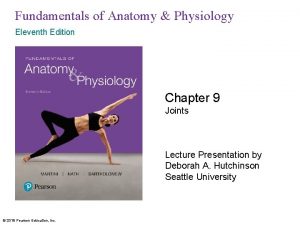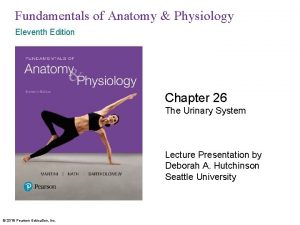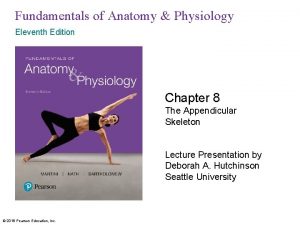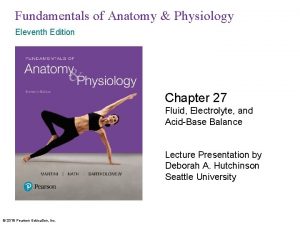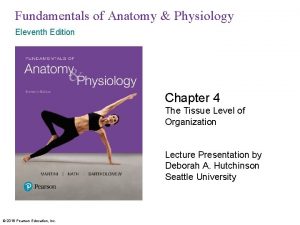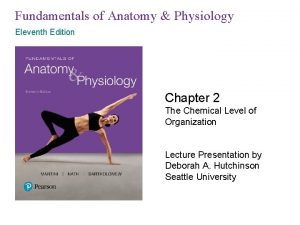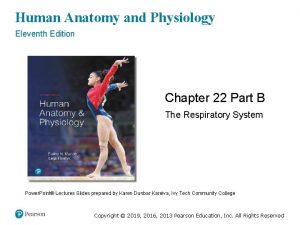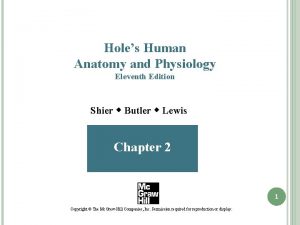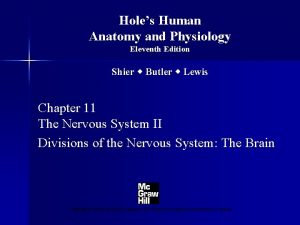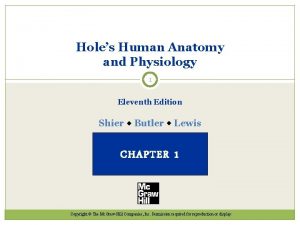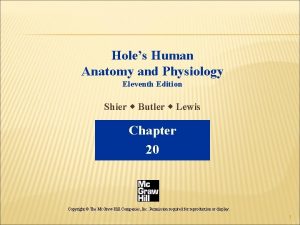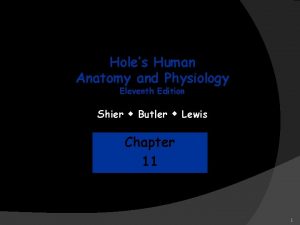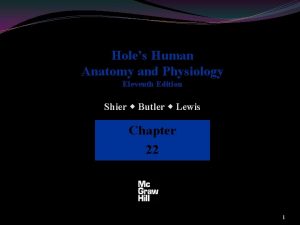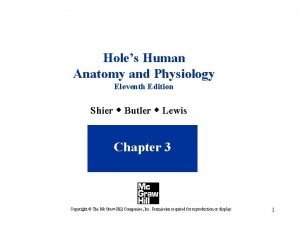Fundamentals of Anatomy Physiology Eleventh Edition Chapter 7

































































































































- Slides: 129

Fundamentals of Anatomy & Physiology Eleventh Edition Chapter 7 The Axial Skeleton Lecture Presentation by Deborah A. Hutchinson Seattle University © 2018 Pearson Education, Inc.

Learning Outcomes 7 -1 Identify the bones of the axial skeleton, and specify their functions. 7 -2 Identify the bones, foramina, and fissures of the cranium and face, and explain the significance of the markings on the individual bones. 7 -3 Describe the structure and functions of the orbital complex, nasal complex, and paranasal sinuses. 7 -4 Describe the key structural differences among the skulls of infants, children, and adults. 2 © 2018 Pearson Education, Inc.

Learning Outcomes 7 -5 Identify and describe the curves of the spinal column, and indicate the function of each. 7 -6 Identify the five vertebral regions, and describe the distinctive structural and functional characteristics of the vertebrae in each region. 7 -7 Explain the significance of the joints between the thoracic vertebrae and ribs, and between the ribs and sternum. 3 © 2018 Pearson Education, Inc.

SKELETAL SYSTEM 206 AXIAL SKELETON 80 Skull and associated bones Thoracic cage 29 Associated bones 25 Cranium Face 8 14 Auditory ossicles 6 Hyoid 1 Sternum 1 Ribs 24 Vertebrae 24 • Axial skeleton Vertebral column 26 • Bones of head and trunk • Forms longitudinal axis of body Sacrum 1 Coccyx 1 • Appendicular skeleton • Bones that support the limbs a An anterior view of the entire skeleton, with the axial components highlighted. The numbers in the boxes indicate the number of bones in the adult skeleton. APPENDICULAR SKELETON (see Figure 8 -1)

7 -1 The Axial Skeleton § Axial skeleton has 80 bones – Skull • 8 cranial bones and 14 facial bones – Bones associated with the skull • 6 auditory ossicles and hyoid bone – Thoracic cage • Sternum and 24 ribs – Vertebral column • 24 vertebrae, sacrum, and coccyx 5 © 2018 Pearson Education, Inc.

Figure 7– 1 b The Axial Skeleton. Skull Cervical vertebrae Sternum Ribs Thoracic vertebrae Costal cartilages Lumbar vertebrae Sacrum Coccyx b Anterior (top) and posterior (bottom) views of the axial skeleton. The individual bones associated with the skull are not visible. © 2018 Pearson Education, Inc. 6

7 -1 The Axial Skeleton § Functions of the axial skeleton – Supports and protects organs in body cavities – Provides points of attachment for muscles that • Adjust positions of head, neck, and trunk • Perform breathing movements • Stabilize parts of appendicular skeleton 7 © 2018 Pearson Education, Inc.

7 -2 The Skull § The skull contains 22 bones – 8 cranial bones form the cranium • Including calvaria (skullcap) • Enclose cranial cavity, containing the brain – 14 facial bones • Protect and support entrances to digestive and respiratory tracts a CRANIUM 8 Occipital bone 1 Parietal bones 2 Frontal bone 1 Temporal bones 2 Sphenoid 1 Ethmoid 1 Parietal bone Frontal bone Temporal bone Ethmoid Sphenoid Occipital bone Cranial bones surround and protect the brain. 8 © 2018 Pearson Education, Inc.

7 -2 The Skull § Facial bones – 9 superficial facial bones • For muscle attachment – 5 deeper facial bones • Help separate oral and nasal cavities • Increase surface area of nasal cavities • Help form the nasal septum b FACE 14 Maxillae 2 Palatine bones 2 Nasal bones 2 Inferior nasal conchae 2 Zygomatic bones 2 Lacrimal bones 2 Vomer 1 Mandible 1 Nasal bone Lacrimal bone Vomer Zygomatic bone Maxilla Mandible Facial bones protect and support the entrances to the digestive and respiratory tracts. 9 © 2018 Pearson Education, Inc.

Figure 7– 2 c Cranial and Facial Subdivisions of the Skull. c ASSOCIATED BONES Hyoid bone 1 7 Auditory ossicles enclosed in temporal bones (detailed in Chapter 17) 6 Hyoid bone Auditory ossicles The auditory ossicles would fit easily on the surface of a dime. 10 © 2018 Pearson Education, Inc.

7 -2 The Skull § Sutures – Immovable joints of the skull 1. Lambdoid suture − Separates occipital from parietal bones − May contain sutural bones (Wormian bones) 2. Coronal suture − Attaches frontal bone to parietal bones 3. Sagittal suture − Between parietal bones − From lambdoid suture to coronal suture 4. Squamous sutures − Join temporal bones with parietal bones 11 © 2018 Pearson Education, Inc.

Figure 7– 3 a The Adult Skull. Major Sutures of the Skull Parietal bone (left) Parietal bone (right) Sagittal suture Lambdoid suture Occipital bone Squamous suture Temporal bone Mastoid process Styloid process Occipital condyle External occipital protuberance Mandible a Posterior view © 2018 Pearson Education, Inc. 12

Figure 7– 3 b The Adult Skull. Occipital bone Parietal bone (right) Parietal bone (left) Major Sutures of the Skull Lambdoid suture Sagittal suture Coronal suture Frontal bone Zygomatic Bone Nasal bones b Superior view © 2018 Pearson Education, Inc. 13

Figure 7– 3 c The Adult Skull. Major Sutures of the Skull Parietal bone Coronal suture Frontal bone Sphenoid Supra-orbital foramen Squamous suture Temporal bone Lambdoid suture Nasal bone Lacrimal bone Squamous part of temporal bone External acoustic meatus Ethmoid Infra-orbital foramen Maxilla Zygomatic bone Occipital bone Mastoid process Zygomatic arch Styloid process Zygomatic process of temporal bone Temporal process of zygomatic bone Mandible Mental foramen Mental protuberance c Lateral view 14 © 2018 Pearson Education, Inc.

7 -2 The Skull § Sinuses – Air-filled chambers in the skull – Functions • Decrease weight of the skull • Lined with mucous membranes, which produce mucus to moisten and clean the air • Serve as resonating chambers in speech production 15 © 2018 Pearson Education, Inc.

7 -2 Cranial Bones of the Skull § Cranial bones – Occipital bone – Parietal bones – Frontal bone – Temporal bones – Sphenoid – Ethmoid 16 © 2018 Pearson Education, Inc.

7 -2 Cranial Bones of the Skull § Occipital bone • Forms much of posterior and inferior surfaces of cranium – Joints • Parietal bones • Temporal bones • Sphenoid • First cervical vertebra (atlas) – Foramina • Foramen magnum connects cranial cavity with vertebral canal • Jugular foramen for internal jugular vein • Hypoglossal canals for hypoglossal nerves 17 © 2018 Pearson Education, Inc.

7 -2 Cranial Bones of the Skull § Occipital bone – Regions/markings • External occipital protuberance—small bump at midline on inferior surface • External occipital crest for attachment of ligamentum nuchae • Occipital condyles articulate with first vertebra • Inferior and superior nuchal lines are attachment sites of muscles and ligaments 18 © 2018 Pearson Education, Inc.

Figure 7– 5 a The Occipital and Parietal Bones. Hypoglossal canal Occipital condyle Foramen magnum External occipital crest Inferior nuchal line Superior nuchal line External occipital protuberance a Occipital bone, inferior view 19 © 2018 Pearson Education, Inc.

7 -2 Cranial Bones of the Skull § Parietal bones • Form part of superior and lateral surfaces of the cranium – Joints • With each other and with occipital, temporal, frontal, and sphenoid bones – Regions/markings • Superior and inferior temporal lines attach temporalis muscle • Grooves for cranial blood vessels 20 © 2018 Pearson Education, Inc.

Figure 7– 5 b The Occipital and Parietal Bones. Superior temporal line Inferior temporal line b Right parietal bone, lateral view 21 © 2018 Pearson Education, Inc.

7 -2 Cranial Bones of the Skull § Frontal bone • Forms the anterior part of cranium and roof of eye sockets • Contains frontal sinuses – Joints • Parietal, sphenoid, ethmoid, nasal, lacrimal, maxillary, and zygomatic bones – Foramina • Supra-orbital foramen – For blood vessels of eyebrows, eyelids, and frontal sinuses • Supra-orbital notch – An incomplete supra-orbital foramen 22 © 2018 Pearson Education, Inc.

7 -2 Cranial Bones of the Skull § Frontal bone – Regions/markings • Forehead • Supra-orbital margin (protects eye) • Glabella (between supra-orbital margins) • Lacrimal fossa (for lacrimal gland) • Frontal sinuses 23 © 2018 Pearson Education, Inc.

Figure 7– 6 a The Frontal Bone. Frontal (metopic) suture Forehead Glabella Supra-orbital notch margin a Anterior surface © 2018 Pearson Education, Inc. Superior temporal line 24

Figure 7– 6 b The Frontal Bone. Supra-orbital foramen Lacrimal fossa Supra-orbital margin Frontal sinus b Inferior (orbital) surface 25 © 2018 Pearson Education, Inc.

7 -2 Cranial Bones of the Skull § Temporal bones • Form parts of lateral walls of cranium and zygomatic arches • Articulate with mandible • Surround and protect internal ear • Attach muscles of jaws and head – Joints • Zygomatic, sphenoid, parietal, and occipital bones, and mandible 26 © 2018 Pearson Education, Inc.

7 -2 Cranial Bones of the Skull § Temporal bones – Regions/markings • Squamous part – Borders the squamous suture • Zygomatic process – Inferior to the squamous part – Articulates with temporal process of zygomatic bone – Together, these processes form zygomatic arch • Mandibular fossa – Site of articulation with mandible 27 © 2018 Pearson Education, Inc.

7 -2 Cranial Bones of the Skull § Temporal bones – Regions/markings (cont. ) • Mastoid process – For muscle attachment – Contains mastoid cells that connect to middle ear cavity • Styloid process – Attaches tendons and ligaments of the hyoid, tongue, and pharynx • Petrous part – Encloses structures of internal ear 28 © 2018 Pearson Education, Inc.

7 -2 Cranial Bones of the Skull § The auditory ossicles – Three tiny bones in tympanic cavity (middle ear) – Transfer sound vibrations from tympanic membrane (eardrum) to internal ear § Temporal bones – Foramina • Carotid canal for internal carotid artery • Foramen lacerum contains – Hyaline cartilage – Small arteries – Auditory tube 29 © 2018 Pearson Education, Inc.

7 -2 Cranial Bones of the Skull § Temporal bones – Foramina • Carotid canal for internal carotid artery • Foramen lacerum contains – Hyaline cartilage – Small arteries – Auditory tube • External acoustic meatus ends at tympanic membrane • Stylomastoid foramen for facial nerve • Internal acoustic meatus contains – Blood vessels and nerves of internal ear – Facial nerve 30 © 2018 Pearson Education, Inc.

Figure 7– 7 a The Temporal Bones. Petrous part Squamous part (cerebral surface) Internal acoustic meatus Zygomatic process Mastoid process Styloid process a Medial view of the right temporal bone 31 © 2018 Pearson Education, Inc.

Figure 7– 7 b The Temporal Bones. Squamous part External acoustic meatus Mandibular fossa Zygomatic process Styloid process Mastoid process b Lateral view of the right temporal bone © 2018 Pearson Education, Inc. 32

Figure 7– 7 bc The Temporal Bones. Squamous part External acoustic meatus Mandibular fossa Zygomatic process Styloid process Mastoid process b Lateral view of the right temporal bone Mastoid process, cut to show mastoid cells c A cutaway view of the mastoid cells © 2018 Pearson Education, Inc. 33

7 -2 Cranial Bones of the Skull § Sphenoid – General functions • Forms part of the floor of the cranium • Unites cranial and facial bones • Strengthens sides of the skull – Contains sphenoidal sinuses – Joints • Ethmoid and frontal, occipital, parietal, and temporal bones, palatine bones, zygomatic bones, maxillae, and vomer 34 © 2018 Pearson Education, Inc.

7 -2 Cranial Bones of the Skull § Sphenoid – Regions/markings • Body – Forms central axis of the sphenoid • Sella turcica – Saddle-shaped enclosure – On superior surface of the body • Hypophyseal fossa – A depression within the sella turcica – Holds the pituitary gland 35 © 2018 Pearson Education, Inc.

7 -2 Cranial Bones of the Skull § Sphenoid – Regions/markings • Sphenoidal sinuses – On either side of the body – Inferior to the sella turcica • Lesser wings – Extend horizontally anterior to sella turcica • Greater wings – Extend laterally from the body – Form parts of cranial floor and posterior wall orbit – Sphenoidal spine lies at corner of each wing • Pterygoid processes – Form pterygoid plates 36 – To attach muscles of the lower jaw and soft palate © 2018 Pearson Education, Inc.

7 -2 Cranial Bones of the Skull § Sphenoid – Foramina • Optic canals for optic nerves • Prechiasmatic sulcus (optic groove) • Superior orbital fissure – For blood vessels and nerves of the orbit • Foramen rotundum and foramen ovale – For blood vessels and nerves of face and jaws • Foramen spinosum – For blood vessels and nerves of membranes 37 © 2018 Pearson Education, Inc.

Figure 7– 8 a The Sphenoid. Foramen Prechiasmatic Optic canal rotundum sulcus Foramen ovale Lesser wing Greater wing Foramen spinosum Sella turcica Sphenoidal spine a Superior surface 38 © 2018 Pearson Education, Inc.

Figure 7– 8 b The Sphenoidal Superior sinus orbital fissure Greater wing Orbital surface Lesser wing Body Foramen rotundum Pterygoid process Pterygoid plates b Anterior surface 39 © 2018 Pearson Education, Inc.

7 -2 Cranial Bones of the Skull § Ethmoid • Forms – Anteromedial floor of the cranium – Roof of the nasal cavity – Part of the nasal septum and medial orbital wall • Contains ethmoidal cells (network of sinuses) – Joints • Frontal bone, sphenoid, maxillae, nasal, lacrimal, palatine bones, inferior nasal conchae, and vomer 40 © 2018 Pearson Education, Inc.

7 -2 Cranial Bones of the Skull § Ethmoid – Regions/markings • Cribriform plate – Forms roof of nasal cavity and floor of cranium (part) – Contains crista galli to attach falx cerebri • Ethmoidal labyrinths – Consist of ethmoidal cells (air-filled cavities) – Superior nasal conchae – Middle nasal conchae • Perpendicular plate – Forms part of nasal septum 41 © 2018 Pearson Education, Inc.

7 -2 Cranial Bones of the Skull § Ethmoid – Foramina • Olfactory foramina – In the cribriform plate – For olfactory nerves 42 © 2018 Pearson Education, Inc.

Figure 7– 9 a The Ethmoidal labyrinth Olfactory foramina Cribriform plate Crista galli Perpendicular plate a Superior surface © 2018 Pearson Education, Inc. 43

Figure 7– 9 b The Ethmoid. Crista galli Superior nasal concha Perpendicular plate © 2018 Pearson Education, Inc. b Posterior surface Middle nasal concha 44

7 -2 Facial Bones of the Skull § Facial bones – Maxillae – Palatine bones – Nasal bones – Vomer – Inferior nasal conchae – Zygomatic bones – Lacrimal bones – Mandible – Hyoid bone 45 © 2018 Pearson Education, Inc.

7 -2 Facial Bones of the Skull § Maxillae – General functions • Support upper teeth • Form inferior orbital rims • Form lateral margins of external nares • Form upper jaw and most of hard palate • Contain maxillary sinuses (largest sinuses) – Joints • Frontal bones, ethmoid, and with one another • All other facial bones except the mandible 46 © 2018 Pearson Education, Inc.

7 -2 Facial Bones of the Skull § Maxillae – Regions/markings • Orbital rim protects eye and other structures • Anterior nasal spine attaches anterior nasal septum • Alveolar process supports upper teeth • Palatine processes form most of hard palate • Maxillary sinuses lighten the bone • Nasolacrimal canal protects lacrimal sac and nasolacrimal duct 47 © 2018 Pearson Education, Inc.

7 -2 Facial Bones of the Skull § Maxillae – Foramina • Infra-orbital foramen – For sensory nerve to brain (via foramen rotundum of sphenoid) • Inferior orbital fissure – For cranial nerves and blood vessels 48 © 2018 Pearson Education, Inc.

Figure 7– 10 a The Maxillae and Palatine Bones. Orbital rim Infraorbital foramen Alveolar process Anterior nasal spine Zygomatic process a Lateral view of the right maxilla. 49 © 2018 Pearson Education, Inc.

7 -2 Facial Bones of the Skull § Palatine bones – General functions • Form posterior portions of hard palate • Contribute to the floors of the orbits – Joints • With each other, maxillae, sphenoid, ethmoid, inferior nasal conchae, and vomer 50 © 2018 Pearson Education, Inc.

7 -2 Facial Bones of the Skull § Palatine bones – Regions/markings • Horizontal plate forms posterior part of hard palate • Perpendicular plate extends from horizontal plate to orbital process of orbit floor – Foramina • Many in the lateral portion of the horizontal plate • For small blood vessels and nerves of roof of the mouth 51 © 2018 Pearson Education, Inc.

Figure 7– 10 b The Maxillae and Palatine Bones. Palatine bone (horizontal plate) Palatine process Alveolar process Maxillary sinus b Superior view of a horizontal section through right maxilla and palatine bone; note the size and orientation of the maxillary sinus. 52 © 2018 Pearson Education, Inc.

Figure 7– 10 c The Maxillae and Palatine Bones. Orbital process Horizontal plate Perpendicular plate c Anterior view of the two palatine bones. 53 © 2018 Pearson Education, Inc.

7 -2 Facial Bones of the Skull § Nasal bones • Support bridge of the nose • Connect to cartilages of distal parts of the nose that extend to external nares – Joints • With each other, ethmoid, frontal bone, and maxillae § Vomer • Forms inferior portion of the bony nasal septum – Joints • Maxillae, sphenoid, ethmoid, and palatine bones • Cartilaginous part of the nasal septum 54 © 2018 Pearson Education, Inc.

7 -2 Facial Bones of the Skull § Inferior nasal conchae – General functions • Slow inhaled air • Create air turbulence in the nasal cavity • Increase epithelial surface area to warm and humidify inhaled air – Joints • Maxillae, ethmoid, palatine, and lacrimal bones 55 © 2018 Pearson Education, Inc.

7 -2 Facial Bones of the Skull § Zygomatic bones • Contribute to rims and lateral walls of orbits • Form parts of zygomatic arches – Joints • Maxillae, sphenoid, frontal, and temporal bones – Regions/markings • Temporal process – Meets the zygomatic process of temporal bone – Foramina • Zygomaticofacial foramen – For a sensory nerve of cheek 56 © 2018 Pearson Education, Inc.

Figure 7– 11 The Smaller Bones of the Face (Part 1 of 2). Supra-orbital foramen Nasal bone Sphenoid Temporal bone Zygomaticofacial foramen Zygomatic bone Infra-orbital foramen Maxilla Perpendicular plate Vomer of ethmoid Bony nasal septum © 2018 Pearson Education, Inc. 57

7 -2 Facial Bones of the Skull § Lacrimal bones – Smallest facial bones – General functions • Form parts of medial walls of orbits – Joints • Frontal bone, maxillae, and ethmoid – Regions/markings • Lacrimal sulcus – Location of the lacrimal sac – Leads to the nasolacrimal canal 58 © 2018 Pearson Education, Inc.

Figure 7– 11 The Smaller Bones of the Face (Part 2 of 2). Lacrimal sulcus Optic canal Superior orbital fissure Lacrimal bone Middle nasal concha Inferior nasal concha Temporal process of zygomatic bone Mastoid process Perpendicular plate Vomer of ethmoid Bony nasal septum 59 © 2018 Pearson Education, Inc.

7 -2 Facial Bones of the Skull § Mandible • Forms the lower jaw – Joints • Mandibular fossae of the temporal bones Articular surface for temporomandibular joint Coronoid process Teeth Mandibular notch Alveolar part Head Body Condylar process Mental protuberance Ramus Angle a A lateral and slightly superior view of the mandible © 2018 Pearson Education, Inc. Mental foramen 60

7 -2 Facial Bones of the Skull § Mandible – Regions/markings • Body of the mandible is horizontal portion • Alveolar part supports the lower teeth • Mental protuberance attaches facial muscles • A depression on the medial surface for submandibular salivary gland • Mylohyoid line for insertion of mylohyoid muscle • Ramus ascending from the angle of the mandible on either side 61 © 2018 Pearson Education, Inc.

7 -2 Facial Bones of the Skull § Mandible – Regions/markings • On each ramus – Condylar process articulates with temporal bone at temporomandibular joint – Coronoid process—insertion point for temporalis muscle (closes the jaws) – Mandibular notch separates condylar and coronoid processes 62 © 2018 Pearson Education, Inc.

7 -2 Facial Bones of the Skull § Mandible – Foramina • Mental foramina – For sensory nerves of lips and chin • Mandibular foramen – Entrance to mandibular canal – For blood vessels and nerves of lower teeth 63 © 2018 Pearson Education, Inc.

Figure 7– 12 a The Mandible. Articular surface for temporomandibular joint Coronoid process Teeth Mandibular notch Alveolar part Head Body Condylar process Mental protuberance Ramus Angle Mental foramen a A lateral and slightly superior view of the mandible 64 © 2018 Pearson Education, Inc.

Figure 7– 12 b The Mandible. Coronoid process Alveolar part Articular surface Condylar process Mandibular foramen Mylohyoid line b A medial view of the right mandible Depression for submandibular salivary gland 65 © 2018 Pearson Education, Inc.

7 -2 Facial Bones of the Skull § Hyoid bone • Supports the larynx • Attaches muscles of larynx, pharynx, and tongue – Joints • Stylohyoid ligaments connect lesser horns to styloid processes of temporal bones Greater horn Lesser horn Body Superior view of the hyoid bone © 2018 Pearson Education, Inc. 66

7 -2 Facial Bones of the Skull § Hyoid bone – Regions/markings • Body of the hyoid – Attaches muscles of larynx, pharynx, and tongue • Greater horns – Support larynx – Attach muscles of the tongue • Lesser horns – Attach stylohyoid ligaments – Support hyoid and larynx 67 © 2018 Pearson Education, Inc.

7 -3 Orbital and Nasal Complexes § Orbits (eye sockets) – Seven bones of orbital complex form each orbit • Frontal bone (roof) • Maxilla (floor) • Maxilla, lacrimal bone, and ethmoidal labyrinth (orbital rim and medial wall) • Sphenoid and palatine bones • Zygomatic bone (lateral wall and rim of orbit) 68 © 2018 Pearson Education, Inc.

Figure 7– 14 The Orbital Complex (Part 1 of 2). Frontal bone Supra-orbital notch Sphenoid Optic canal Superior orbital fissure Ethmoid Lacrimal bone Palatine bone Lacrimal sulcus Nasolacrimal canal Zygomatic bone Maxilla Inferior orbital fissure Infra-orbital foramen groove 69 © 2018 Pearson Education, Inc.

Figure 7– 14 The Orbital Complex (Part 2 of 2). Supra-orbital notch Frontal bone Sphenoid Optic canal Superior orbital fissure Ethmoid Lacrimal bone Nasolacrimal canal Inferior orbital fissure Zygomatic bone Infra-orbital Maxilla foramen groove 70 © 2018 Pearson Education, Inc.

7 -3 Orbital and Nasal Complexes § Nasal complex – Made up of bones enclosing nasal cavities and paranasal sinuses • Frontal bone, sphenoid, and ethmoid – Superior wall of nasal cavities • Maxillae, lacrimal bones, ethmoid, and inferior nasal conchae – Lateral walls of nasal cavities • Maxillae and nasal bones – Bridge of nose 71 © 2018 Pearson Education, Inc.

Figure 7– 15 a The Nasal Complex. Frontal bone Frontal sinuses Sphenoid Ethmoid Nasal bone Sphenoidal sinus Nasal conchae of ethmoid Maxilla (bony palate) Palatine bone (bony palate) Superior Middle Inferior nasal concha a A sagittal section through the skull, with the nasal septum removed to show major features of the wall of the right nasal cavity. The frontal and sphenoidal sinuses are visible. © 2018 Pearson Education, Inc. 72

7 -3 Orbital and Nasal Complexes § Paranasal sinuses – Air-filled chambers connected to nasal cavities Frontal sinus • Lighten skull bones Ethmoidal cells • Contain mucous Sphenoidal sinus epithelium Maxillary sinus – Releases mucus into nasal cavities b Locations of the paranasal sinuses. 73 © 2018 Pearson Education, Inc.

7 -4 Fontanelles § Infant skull – Grows rapidly – Is large compared to the body – Has many ossification centers – Fusion of bones is not complete at birth • Two frontal bones • Four occipital bones • Several sphenoid and temporal elements § Fontanelles – Large areas of fibrous connective tissue – Cover unfused sutures in the infant skull – Allow the skull to flex during birth 74 © 2018 Pearson Education, Inc.

7 -4 Fontanelles § Sphenoidal fontanelles – At junction of squamous and coronal sutures § Mastoid fontanelles – At junction of squamous and lambdoid sutures § Anterior fontanelle (“soft spot”) – At intersection of frontal, sagittal, and coronal sutures § Posterior fontanelle – At junction of lambdoid and sagittal sutures 75 © 2018 Pearson Education, Inc.

Figure 7– 16 a Infant Skull and Fontanelles Sphenoidal Mastoid fontanelle Coronal suture Frontal bone Parietal bone Greater wing of sphenoid Nasal bone Maxilla Mandible Temporal Squamous Occipital Lambdoid bone suture a Lateral view © 2018 Pearson Education, Inc. 76

Figure 7– 16 b Infant Skull and Fontanelles Anterior fontanelle Posterior fontanelle Coronal suture Frontal bone Frontal suture Frontal bone Parietal bone Occipital bone Sagittal suture Parietal bone Coronal suture Lambdoid suture b Superior view 77 © 2018 Pearson Education, Inc.

Figure 7– 3 d The Adult Skull. Sagittal suture Foramen or Fissure Parietal bone Coronal suture Frontal Bone Nasal bone Supra-orbital foramen Ethmoid Temporal bone Optic canal • Supra-orbital artery • Optic nerve (II) • Ophthalmic artery Lacrimal bone Zygomatic bone Mastoid process of temporal bone Middle nasal concha (part of ethmoid) Superior orbital fissure • Oculomotor nerve (III), trochlear nerve (IV), opthalmic branch of trigeminal nerve (V), and abducens nerve (VI) Inferior orbital fissure • Maxillary division (V 2) of trigeminal nerve(V) Maxilla Inferior nasal concha Infra-orbital foramen Bony nasal septum • Infra-orbital nerve, branch of maxillary nerve (V 2) • Infra-orbital artery Perpendicular plate of ethmoid Mental protuberance • Supra-orbital nerve (branch of CN V) Sphenoid Palatine bone Vomer Major Structures Using Passageway Mandible d Anterior view Mental foramen • Mental nerve, branch of mandibular nerve (V 3) • Mental vessels 78 © 2018 Pearson Education, Inc.

Figure 7– 3 e The Adult Skull. Frontal bone Sphenoid Maxilla Palatine bone Zygomatic arch Medial and lateral pterygoid processes Foramen lacerum (with temporal and occipital bones) • Internal carotid artery after leaving carotid canal Foramen ovale • Mandibular division (V 3) of trigeminal nerve (V) • Auditory tube Temporal Bone External acoustic meatus • Air in meatus conducts sound to eardrum Occipital condyle Carotid canal • Internal carotid artery Mastoid process Stylomastoid foramen • Facial nerve (V) Vomer Styloid process Mandibular fossa Occipital Bone Foramen magnum Lambdoid suture • Medulla oblongata (most caudal portion of brain) • Accessory nerve (XI) Occipital bone • Vertebral arteries External occipital protuberance e Inferior view Jugular foramen • Glossopharyngeal, vagus, and (with temporal accessory nerves (IX, X, XI) bone) • Internal jugular vein 79 © 2018 Pearson Education, Inc.

Figure 7– 4 a Sectional Anatomy of the Skull. THE CRANIAL CAVITY This sagittal section of the skull was taken just lateral to the nasal septum. It gives the best view of the cranial cavity. The colored boxes highlight the bones that surround the cranial cavity, and some of their key markings are highlighted within their respective boxes. Parietal Bone Sphenoid Hypophyseal fossa within sella turcica Coronal suture Sphenoidal sinus Frontal Bone Squamous suture Frontal sinuses Temporal Bone Internal acoustic meatus Nasal bone Ethmoid Styloid process Crista galli Cribriform plate Lambdoid suture Vomer Palatine bone Occipital Bone Maxilla Hypoglossal canal Foramen magnum Mandible a Sagittal section © 2018 Pearson Education, Inc. 80

Figure 7– 4 b Sectional Anatomy of the Skull. THE FLOOR OF THE CRANIUM This superior view of a horizontal section through the skull shows the floor of the cranial cavity. This is where most of the nerves and blood vessels enter or leave the cranial cavity. Compare this figure and chart with Figure 7– 3 e showing the inferior view of the skull and Figure 14– 18 (p. 495) showing the origin of the cranial nerves. Foramen or Fissure Major Structures Using Passageway Ethmoid Olfactory foramina • Olfactory nerve (I) Sphenoid Frontal bone Crista galli Cribriform plate Sella turcica Optic canal • Optic nerve (II) • Ophthalmic artery Foramen rotundum • Maxillary division (V 2) of trigeminal nerve (V) Foramen lacerum • Internal carotid artery after leaving carotid canal • Auditory tube Foramen ovale • Mandibular division (V 3) of trigeminal nerve (V) Foramen spinosum • Blood vessels to membranes around central nervous system Temporal Bone Carotid canal • Internal carotid artery Internal acoustic meatus • Vestibulocochlear nerve (VIII) • Internal acoustic artery • Facial nerve (VII) Parietal bone Occipital Bone Internal occipital crest b Horizontal section Understanding skull structure will be especially important to you in later chapters when you study the nervous and cardiovascular systems. © 2018 Pearson Education, Inc. Foramen magnum • Medulla oblongata (most caudal portion of brain) • Accessory nerve (XI) • Vertebral arteries Hypoglossal canal • Hypoglossal nerve (XII) Jugular foramen (with temporal bone) • Glossopharyngeal, vagus, and accessory nerves (IX, X, XI) • Internal jugular vein 81

7 -5 The Vertebral Column § Vertebral column (spine) – Protects the spinal cord – Supports the head and body – 26 bones § Spinal curves – Cervical curve – Thoracic curve – Lumbar curve – Sacral curve • 24 vertebrae, the sacrum, and the coccyx § Thoracic and sacral curves – Called primary curves (accommodation curves) – Present during fetal development; Accommodate internal organs § Cervical and lumbar curves – Called secondary curves (compensation curves) – Appear after birth – Shift body weight to permit upright posture 82 © 2018 Pearson Education, Inc.

Figure 7– 17 The Vertebral Column. Spinal Curves Vertebral Regions Primary curves develop before birth, and secondary curves after birth. Regions are defined by structural characteristics of individual vertebrae. The cervical curve, a secondary curve, develops as the infant learns to balance the weight of its head on the vertebrae of the neck. The thoracic curve, a primary curve, provides room for the thoracic organs. The lumbar curve, a secondary curve, balances the weight of the trunk over the lower limbs. This curve develops with the ability to stand. C 1 C 2 C 3 C 4 C 5 C 6 C 7 T 1 T 2 T 3 T 4 T 5 T 6 T 7 T 8 T 9 T 10 T 11 Cervical (7 vertebrae) Thoracic (12 vertebrae) T 12 L 1 L 2 L 3 Lumbar (5 vertebrae) L 4 L 5 The sacral curve, a primary curve, provides room for various abdominopelvic organs. © 2018 Pearson Education, Inc. Sacral Coccygeal 83

7 -6 The Five Vertebral Regions § Vertebrae – Neck • 7 cervical vertebrae – Upper back • 12 thoracic vertebrae • Each articulates with one or more pairs of ribs – Lower back • 5 lumbar vertebrae 84 © 2018 Pearson Education, Inc.

7 -6 The Five Vertebral Regions § Vertebral anatomy – Each vertebra consists of three parts • Vertebral body • Vertebral arch • Articular processes Vertebral arch Articular processes Pedicle Laminae Vertebral body a The major parts of a typical vertebra © 2018 Pearson Education, Inc. 85

7 -6 The Five Vertebral Regions § Vertebral anatomy – Vertebral body • Transfers weight along the spine • Forms anterior margin of each vertebral foramen – Vertebral arch forms posterior margin of each vertebral foramen • Walls are called pedicles • Laminae form roof – Articular processes • Lateral projections between laminae and pedicles 86 © 2018 Pearson Education, Inc.

7 -6 The Five Vertebral Regions § Vertebral anatomy – Spinous process • Posterior projection from where vertebral laminae fuse – Transverse processes • Projections from where laminae join pedicles – Superior and inferior articular processes • Have articular facets • For articulations with neighboring vertebrae 87 © 2018 Pearson Education, Inc.

Figure 7– 18 b Vertebral Anatomy. Superior articular process Pedicle Transverse process Vertebral body Spinous process Inferior articular facet Inferior articular process Arrow passing through vertebral foramen b A lateral and slightly inferior view of a vertebra 88 © 2018 Pearson Education, Inc.

Figure 7– 18 c Vertebral Anatomy. Spinous process Superior articular process Inferior articular process Transverse process Inferior articular facet Vertebral foramen Pedicle Vertebral body c An inferior view of a vertebra 89 © 2018 Pearson Education, Inc.

7 -6 The Five Vertebral Regions § Intervertebral discs – Pads of fibrocartilage – Separate adjacent vertebral bodies § Intervertebral foramina – Gaps between pedicles of adjacent vertebrae – For nerve connections to spinal cord § Vertebral canal – Formed by vertebral foramina of successive vertebrae – Encloses the spinal cord 90 © 2018 Pearson Education, Inc.

Figure 7– 18 d Vertebral Anatomy. Superior articular facets Superior articular process Lamina of vertebral arch Spinous process Intervertebral disc Transverse process Vertebral body Inferior articular process d A posterior view of three articulated vertebrae © 2018 Pearson Education, Inc. 91

Figure 7– 18 e Vertebral Anatomy. Superior articular facets Lamina of vertebral arch Intervertebral foramen Intervertebral disc Spinous process Transverse process Vertebral body Inferior articular facet Arrow passing through vertebral canal e A lateral and sectional view of three articulated vertebrae © 2018 Pearson Education, Inc. 92

7 -6 The Five Vertebral Regions § Vertebrae are numbered – By region, from top (superior) to bottom (inferior) – C 1 articulates with skull, L 5 with sacrum § Vertebrae of each region – Have characteristics determined by functions § Regions of the vertebral column – Cervical (C) – Thoracic (T) – Lumbar (L) – Sacral (S) – Coccygeal (Co) 93 © 2018 Pearson Education, Inc.

7 -6 The Five Vertebral Regions § Cervical vertebrae – C 1 to C 7 – Small body (support only head) – Large vertebral foramen (largest part of spinal cord) – Concave superior surface – Anterior edge is inferior to posterior edge C 1 C 2 C 3 C 4 C 5 Spinous process of vertebra C 6 C 7 prominens a A lateral view of the cervical vertebrae, C 1–C 7. 94 © 2018 Pearson Education, Inc.

7 -6 The Five Vertebral Regions § Cervical vertebrae – Transverse processes are fused to costal processes • Encircle transverse foramina for vertebral arteries and vertebral veins • All except C 1 have spinous processes – Tips of most spinous processes are notched (bifid) – Whiplash—partial or complete dislocation of cervical vertebrae 95 © 2018 Pearson Education, Inc.

Figure 7– 19 b The Cervical Vertebrae. Vertebral arch Spinous process Lamina Superior articular process Vertebral foramen Pedicle Vertebral body Transverse process Costal process Superior Transverse articular facet foramen b A superior view of a representative cervical vertebra (C 3–C 6). Note the typical features listed in Table 7– 1. 96 © 2018 Pearson Education, Inc.

Figure 7– 19 c The Cervical Vertebrae. Transverse process Superior articular process Inferior articular process Spinous process Bifid tip of spinous process Location of transverse foramen Inferior articular facet Vertebral body c A lateral view of the same vertebra as in part b. 97 © 2018 Pearson Education, Inc.

7 -6 The Five Vertebral Regions § Cervical vertebrae – The atlas (C 1) • Articulates with occipital condyles of skull • Has no body or spinous process • Has a large, round vertebral foramen within anterior and posterior arches Dens of Anterior axis arch Transverse ligament Atlas (C 1) Posterior arch Axis (C 2) d The atlas (C 1) and axis (C 2) in posterolateral view. © 2018 Pearson Education, Inc. 98

7 -6 The Five Vertebral Regions § Cervical vertebrae – The axis (C 2) • Articulates with the atlas • Has heavy spinous process to attach muscles of head and neck – Bodies of axis and atlas fuse during development to form the dens Dens of Anterior axis arch Transverse ligament Atlas (C 1) Posterior arch Axis (C 2) d The atlas (C 1) and axis (C 2) in posterolateral view. © 2018 Pearson Education, Inc. 99

7 -6 The Five Vertebral Regions § Cervical vertebrae – The vertebra prominens (C 7) • Transitions to thoracic vertebrae • Has a long spinous process with a broad tubercle • Has large transverse processes – Ligamentum nuchae (elastic ligament) extends from C 7 to skull 100 © 2018 Pearson Education, Inc.

7 -6 The Five Vertebral Regions § Thoracic vertebrae (T 1–T 12) – Have heart-shaped bodies – Larger bodies and relatively smaller vertebral foramina than those in cervical vertebrae Transverse process Spinous process Lamina – Long, slender spinous process – Dorsolateral surfaces of body have costal facets • Articulate with heads of ribs Transverse costal facet Superior Vertebral articular foramen facet Superior Vertebral costal facet body b Thoracic vertebra, superior view. © 2018 Pearson Education, Inc. 101

7 -6 The Five Vertebral Regions § Thoracic vertebrae – T 1–T 8 each articulate with two pairs of ribs • At superior and inferior costal facets – T 9–T 11 articulate with one pair of ribs – T 1–T 10 • Have thick transverse processes • With transverse costal facets for rib articulation – Ribs pairs 1– 10 • Contact costal and transverse costal facets – T 10–T 12 transition to lumbar vertebrae 102 © 2018 Pearson Education, Inc.

Figure 7– 20 a The Thoracic Vertebrae. Vertebra prominens C 7 T 1 T 2 T 3 Intervertebral foramen T 4 T 5 T 6 Thoracic vertebrae (T 1–T 12) T 7 T 8 T 9 T 10 T 11 T 12 L 1 a A lateral view of the thoracic region of the vertebral column. The vertebra prominens (C 7) resembles T 1, but lacks facets for rib articulation. Vertebra T 12 resembles the first lumbar vertebra (L 1) but has a facet for rib articulation. © 2018 Pearson Education, Inc. 103

Figure 7– 20 c The Thoracic Vertebrae. Transverse costal facet for tubercle of superior rib Transverse process Superior costal facet for head of superior rib Vertebral body Spinous process Inferior costal facet for head of inferior rib c Thoracic vertebra, lateral view. 104 © 2018 Pearson Education, Inc.

7 -6 The Five Vertebral Regions § Lumbar vertebrae (L 1–L 5) – Largest vertebrae – Thick, oval-shaped bodies – No costal facets or transverse costal facets – Triangular vertebral foramen – Superior articular processes face medially – Inferior articular processes face laterally – Slender transverse processes project dorsolaterally – Massive spinous processes • For attachment of lower back muscles 105 © 2018 Pearson Education, Inc.

Figure 7– 21 a The Lumbar Vertebrae. L 1 L 2 L 3 L 4 L 5 Sacrum Coccyx a A lateral view of the lumbar vertebrae, sacrum, and coccyx 106 © 2018 Pearson Education, Inc.

Figure 7– 21 b The Lumbar Vertebrae. Spinous process Superior articular facet Lamina Superior articular process Transverse process Vertebral foramen Pedicle Vertebral body b Superior view of typical lumbar vertebra 107 © 2018 Pearson Education, Inc.

Figure 7– 21 c The Lumbar Vertebrae. Superior articular process Pedicle Transverse process Spinous process Inferior articular facet Vertebral body Inferior articular process c Lateral view of a typical lumbar vertebra 108 © 2018 Pearson Education, Inc.

Table 7– 1 Regional Differences in Vertebral Structure and Function (Part 2 of 2) 109 © 2018 Pearson Education, Inc.

7 -6 The Five Vertebral Regions § Sacrum and coccyx – L 5 articulates with the sacrum – Sacrum articulates with the coccyx Articular Entrance to process sacral canal Sacral tuberosity Lateral sacral crest Sacral foramina Median sacral crest Sacral hiatus Sacral cornu Coccygeal cornu Coccyx a A posterior view 110 © 2018 Pearson Education, Inc.

7 -6 The Five Vertebral Regions § Sacrum – Curved, more so in males than in females – Protects reproductive, urinary, and digestive organs – Attaches • Axial skeleton to pelvic girdle • Broad muscles that move thigh § Sacrum – The adult sacrum • Consists of five fused sacral vertebrae • Fusion occurs between puberty and ages 25– 30 – Leaving transverse lines 111 © 2018 Pearson Education, Inc.

7 -6 The Five Vertebral Regions § Sacrum – Sacral canal • Passageway that extends the length of the sacrum • Contains nerves and membranes – Median sacral crest • Ridge formed from fused spinous processes • Four pairs of sacral foramina open to either side – Lateral sacral crest • Ridge formed from fused transverse processes • Attaches to muscles of lower back and hip 112 © 2018 Pearson Education, Inc.

7 -6 The Five Vertebral Regions § Sacrum – Sacral cornua • Ridges formed from laminae of fifth sacral vertebra – Laminae do not meet at midline – Sacral hiatus • Opening at inferior end of sacral canal • Bordered by sacral cornua – Covered by connective tissues – Auricular surface • Thick, flattened area • Articulates with pelvic girdle (forming sacro-iliac joint) 113 © 2018 Pearson Education, Inc.

7 -6 The Five Vertebral Regions § Sacrum – Auricular surface • Thick, flattened area • Articulates with pelvic girdle (forming sacro-iliac joint) – Sacral tuberosity • Roughened area • Attaches ligaments of sacro-iliac joint 114 © 2018 Pearson Education, Inc.

7 -6 The Five Vertebral Regions § Sacrum – Sacral tuberosity • Roughened area • Attaches ligaments of sacro-iliac joint – Apex • Narrow inferior portion • Articulates with the coccyx – Base • Broad superior surface – Sacral promontory • Prominent bulge at anterior tip of base – Ala • A wing on either side of the base • To attach muscles 115

7 -6 The Five Vertebral Regions § Coccyx – Mature coccyx • Consists of three to five fused coccygeal vertebrae – Attaches ligaments and a constricting muscle of the anus – First two coccygeal vertebrae have transverse processes • And unfused vertebral arches – Coccygeal cornu • Prominent lamina of first coccygeal vertebra 116 © 2018 Pearson Education, Inc.

Figure 7– 22 a The Sacrum and Coccyx. Articular Entrance to process sacral canal Sacral tuberosity Lateral sacral crest Sacral foramina Median sacral crest Sacral hiatus Sacral cornu Coccygeal cornu Coccyx a A posterior view © 2018 Pearson Education, Inc. 117

Figure 7– 22 b The Sacrum and Coccyx. Sacral promontory Auricular surface Lateral sacral crest Median sacral crest Sacral cornu Sacral curve Coccygeal cornu Coccyx b A lateral view from the right side © 2018 Pearson Education, Inc. 118

Figure 7– 22 c The Sacrum and Coccyx. Base Sacral promontory Ala Sacral foramina Ala Transverse lines Apex Coccyx © 2018 Pearson Education, Inc. c An anterior view 119

7 -7 The Thoracic Cage § Thoracic cage – The skeleton of the chest – Consists of • Thoracic vertebrae • Ribs • Costal cartilages • Sternum § Functions of thoracic cage – Protects organs of the thoracic cavity • Including heart, lungs, and thymus – Provides attachment for muscles involved in • Breathing • Maintaining position of vertebral column • Moving pectoral girdles § Ribs and sternum form rib cage 120 © 2018 Pearson Education, Inc.

7 -7 The Thoracic Cage § Ribs – 12 pairs of long, curved, flat bones – Extending from thoracic vertebrae – Ribs are divided into two types • True ribs • False ribs § Ribs 1– 7 are true ribs – Vertebrosternal ribs – Connected to sternum by costal cartilages 121 © 2018 Pearson Education, Inc.

7 -7 The Thoracic Cage § Ribs 8– 12 are false ribs – Do not attach directly to sternum – Vertebrochondral ribs (ribs 8– 10) • Costal cartilages fuse together • Merge with cartilages of rib pair 7 before reaching sternum – Floating or vertebral ribs (ribs 11– 12) • Have no connection with the sternum • Connect only to vertebrae and muscles of body wall 122 © 2018 Pearson Education, Inc.

Figure 7– 23 a The Thoracic Cage. T 1 Jugular notch Clavicular articulation 1 Sternum Manubrium 2 3 Body True ribs (ribs 1– 7) 4 Xiphoid process 5 Costal cartilages 10 T 11 T 12 12 Vertebrochondral ribs (ribs 8– 10) Floating ribs (ribs 11– 12) © 2018 Pearson Education, Inc. 11 6 7 8 9 a An anterior view, showing the costal cartilages and the sternum False ribs (ribs 8– 12) 123

Figure 7– 23 b The Thoracic Cage. C 7 T 1 1 2 3 4 5 True ribs (ribs 1– 7) T 4 2 3 4 T 5 5 6 T 7 6 7 T 8 8 T 9 7 8 T 10 10 11 © 2018 Pearson Education, Inc. T 3 1 T 6 9 False ribs (ribs 8– 12) T 2 12 T 11 9 T 12 10 L 1 11 12 b A posterior view, showing the articulations of the ribs and vertebrae 124

7 -7 The Thoracic Cage § Structures of the ribs – Head (capitulum) • At vertebral end of rib • Has superior and inferior articular facets – Neck • Short area between head and tubercle – Tubercle • A small dorsal elevation • Has an articular facet that contacts transverse process of thoracic vertebra (at T 1–T 10 only) – Tubular body (shaft) • Attaches muscles of pectoral girdle and trunk • Attaches intercostal muscles that move the ribs 125 © 2018 Pearson Education, Inc.

Figure 7– 24 a The Ribs. Transverse costal facet Tubercle of rib Angle Neck Demifacet Head (capitulum) Vertebral end a A superior view of a rib showing the joints between it and a thoracic vertebra Head Neck Attachment to Articular facets costal cartilage Tubercle (sternal end) Body Angle b © 2018 Pearson Education, Inc. A posterior view of a typical rib (ribs 2– 9) from the right side Costal groove 126

7 -7 The Thoracic Cage § Sternum (breastbone) – A flat bone in anterior midline of thoracic wall – Three parts of the sternum Clavicular articulation • Manubrium Sternum • Body Manubrium • Xiphoid process Body Xiphoid process 127 © 2018 Pearson Education, Inc.

7 -7 The Thoracic Cage § Manubrium – Superior portion of sternum – Broad, triangular shape – Articulates with clavicles (collarbones) – Articulates with cartilages of first rib pair – Has a jugular notch, a shallow indentation between clavicular articulations § Sternal body – Tongue-shaped – Attaches to manubrium – Attaches to costal cartilages of rib pairs 2– 7 128 © 2018 Pearson Education, Inc.

7 -7 The Thoracic Cage § Xiphoid process – Smallest part of the sternum – Attaches to sternal body – Attaches to diaphragm and rectus abdominis muscle § The developing sternal body – Consists of four separate bones – Fusion is not complete until at least age 25 • Leaving transverse lines § The xiphoid process – Last part of sternum to ossify and fuse – Can be broken easily 129 © 2018 Pearson Education, Inc.
 Management eleventh edition stephen p robbins
Management eleventh edition stephen p robbins Management stephen p robbins 11th edition
Management stephen p robbins 11th edition Management eleventh edition
Management eleventh edition Management eleventh edition
Management eleventh edition 3 layers of muscle
3 layers of muscle Human anatomy & physiology edition 9
Human anatomy & physiology edition 9 Uterus perimetrium
Uterus perimetrium The central sulcus divides which two lobes? (figure 14-13)
The central sulcus divides which two lobes? (figure 14-13) Waistline
Waistline Anatomy and physiology chapter 8 special senses
Anatomy and physiology chapter 8 special senses Chapter 13 anatomy and physiology of pregnancy
Chapter 13 anatomy and physiology of pregnancy Anatomy and physiology chapter 2
Anatomy and physiology chapter 2 Chapter 7 anatomy and physiology
Chapter 7 anatomy and physiology Chapter 14 the digestive system and body metabolism
Chapter 14 the digestive system and body metabolism Chapter 10 blood anatomy and physiology
Chapter 10 blood anatomy and physiology Anatomy and physiology chapter 15
Anatomy and physiology chapter 15 Anatomy and physiology chapter 1
Anatomy and physiology chapter 1 Holes anatomy and physiology chapter 1
Holes anatomy and physiology chapter 1 Gi tract histology
Gi tract histology Anterior posterior distal proximal
Anterior posterior distal proximal Chapter 2 human reproductive anatomy and physiology
Chapter 2 human reproductive anatomy and physiology Appendicular skeleton pectoral girdle
Appendicular skeleton pectoral girdle Chapter 6 general anatomy and physiology
Chapter 6 general anatomy and physiology Cranial cephalic
Cranial cephalic Eleventh 5 year plan
Eleventh 5 year plan Eleventh 5 year plan
Eleventh 5 year plan Eleventh plan
Eleventh plan For his eleventh birthday elvis presley
For his eleventh birthday elvis presley Physiology of sport and exercise 5th edition
Physiology of sport and exercise 5th edition The upper respiratory tract
The upper respiratory tract Tattoo anatomy and physiology
Tattoo anatomy and physiology Anatomy science olympiad
Anatomy science olympiad Incomplete flower
Incomplete flower Anatomy and physiology bones
Anatomy and physiology bones Tripple therapy
Tripple therapy Liver anatomy and physiology
Liver anatomy and physiology Difference between anatomy and physiology
Difference between anatomy and physiology Hypogastric region
Hypogastric region Blood in anatomy and physiology
Blood in anatomy and physiology Http://anatomy and physiology
Http://anatomy and physiology Appendix anatomy and physiology
Appendix anatomy and physiology Aohs foundations of anatomy and physiology 1
Aohs foundations of anatomy and physiology 1 Aohs foundations of anatomy and physiology 1
Aohs foundations of anatomy and physiology 1 Anatomy and physiology of swine
Anatomy and physiology of swine Agriscience unit 26 self evaluation answers
Agriscience unit 26 self evaluation answers Science olympiad anatomy and physiology 2020 cheat sheet
Science olympiad anatomy and physiology 2020 cheat sheet Contraction
Contraction Physiology
Physiology Aohs foundations of anatomy and physiology 1
Aohs foundations of anatomy and physiology 1 Aohs foundations of anatomy and physiology 1
Aohs foundations of anatomy and physiology 1 Anatomy and physiology
Anatomy and physiology Cornell notes for anatomy and physiology
Cornell notes for anatomy and physiology Holes essential of human anatomy and physiology
Holes essential of human anatomy and physiology Anatomy and physiology unit 7 cardiovascular system
Anatomy and physiology unit 7 cardiovascular system Anatomy and physiology
Anatomy and physiology The speed at which the body consumes energy
The speed at which the body consumes energy Aohs foundations of anatomy and physiology 1
Aohs foundations of anatomy and physiology 1 Physiology exam 1
Physiology exam 1 Welcome to anatomy and physiology
Welcome to anatomy and physiology Physiology of the foot and ankle
Physiology of the foot and ankle Anatomy and physiology of psoriasis
Anatomy and physiology of psoriasis Physiology vs anatomy
Physiology vs anatomy Pancreas anatomy histology
Pancreas anatomy histology Anatomy and physiology vocabulary
Anatomy and physiology vocabulary Anatomy and physiology
Anatomy and physiology Anatomy and physiology
Anatomy and physiology Anatomy and physiology
Anatomy and physiology Organ orientation
Organ orientation Anatomy and physiology
Anatomy and physiology Anatomy and physiology
Anatomy and physiology Thyroid anatomy
Thyroid anatomy Dorsifelxion
Dorsifelxion Anatomy and physiology
Anatomy and physiology Anatomy and physiology
Anatomy and physiology Anatomy and physiology
Anatomy and physiology Figure 10-1 blood
Figure 10-1 blood Dorsal root ganglion labeled
Dorsal root ganglion labeled Anatomy and physiology of the eye
Anatomy and physiology of the eye Oblongata
Oblongata Irn.org anatomy and physiology
Irn.org anatomy and physiology Anatomy and physiology body parts
Anatomy and physiology body parts Unit 26 animal anatomy physiology and nutrition
Unit 26 animal anatomy physiology and nutrition Figure 14-2 digestive system
Figure 14-2 digestive system Anatomy and physiology of the retina
Anatomy and physiology of the retina Animal tissue
Animal tissue Anatomy and physiology of meningitis ppt
Anatomy and physiology of meningitis ppt Jeopardy anatomy and physiology game
Jeopardy anatomy and physiology game Anatomy and physiology definition
Anatomy and physiology definition Anatomy and physiology
Anatomy and physiology Respiratory system
Respiratory system Anatomy and physiology trivia
Anatomy and physiology trivia Cycloid scales
Cycloid scales Brain anatomy and physiology
Brain anatomy and physiology Anatomy and physiology
Anatomy and physiology Unit 5 anatomy and physiology
Unit 5 anatomy and physiology 2012 pearson education inc anatomy and physiology
2012 pearson education inc anatomy and physiology Layers of esophagus
Layers of esophagus Fish anatomy and physiology
Fish anatomy and physiology Cengage anatomy and physiology
Cengage anatomy and physiology Fundamentals of information systems 9th edition
Fundamentals of information systems 9th edition Fundamentals of information systems 9th edition
Fundamentals of information systems 9th edition Fluid mechanics fundamentals and applications
Fluid mechanics fundamentals and applications Digital fundamentals 10th edition floyd
Digital fundamentals 10th edition floyd Machining fundamentals 10th edition
Machining fundamentals 10th edition Fundamentals of organizational communication
Fundamentals of organizational communication Fundamentals of organizational communication 9th edition
Fundamentals of organizational communication 9th edition Fundamentals of corporate finance, third canadian edition
Fundamentals of corporate finance, third canadian edition Digital fundamentals floyd 10th edition
Digital fundamentals floyd 10th edition Floyd digital fundamentals 10th edition pdf
Floyd digital fundamentals 10th edition pdf Electronics fundamentals a systems approach
Electronics fundamentals a systems approach Computer security fundamentals 4th edition
Computer security fundamentals 4th edition Management fundamentals 8th edition
Management fundamentals 8th edition Fundamentals of information systems 9th edition
Fundamentals of information systems 9th edition Fundamentals of corporate finance third canadian edition
Fundamentals of corporate finance third canadian edition Fundamentals of corporate finance fifth edition
Fundamentals of corporate finance fifth edition Corporate finance 6th edition
Corporate finance 6th edition Abnormal psychology comer 9th edition
Abnormal psychology comer 9th edition Fundamentals of information systems 9th edition
Fundamentals of information systems 9th edition Fundamentals of heat and mass transfer 4th edition
Fundamentals of heat and mass transfer 4th edition The fundamentals of political science research 2nd edition
The fundamentals of political science research 2nd edition Mis chapter 6
Mis chapter 6 Mis
Mis Brunnstrom's clinical kinesiology 6th edition
Brunnstrom's clinical kinesiology 6th edition Clinical kinesiology and anatomy 6th edition
Clinical kinesiology and anatomy 6th edition Human anatomy fifth edition
Human anatomy fifth edition Human anatomy fifth edition
Human anatomy fifth edition Fundamentals chapter 1
Fundamentals chapter 1 Fundamentals of electric circuits chapter 4 solutions
Fundamentals of electric circuits chapter 4 solutions Fundamentals of corporate finance chapter 6 solutions
Fundamentals of corporate finance chapter 6 solutions Digital fundamentals chapter 4
Digital fundamentals chapter 4


























































